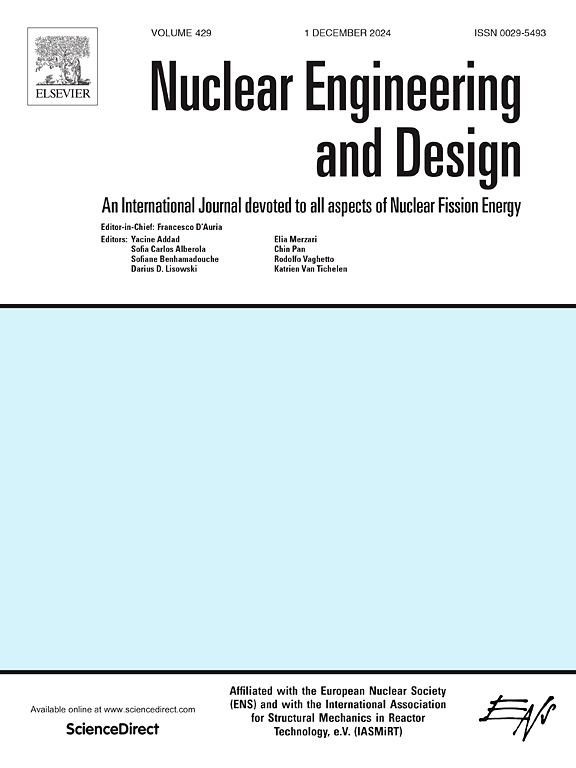核电工程中双密封o形环结构泄漏机理及动态响应特性
IF 1.9
3区 工程技术
Q1 NUCLEAR SCIENCE & TECHNOLOGY
引用次数: 0
摘要
本文建立了o形密封圈的流动阻力模型,并建立了用于预测双密封结构动态响应的MATLAB/SIMULINK仿真求解器。对不同压缩率和气体压力下的流动阻力计算值进行了评估,并与实验数据进行了比较,验证了流动阻力模型的有效性。利用仿真求解器预测了双密封结构在恒压阶跃和正弦激励下的动态泄漏行为,揭示了它们的响应特征分别为指数和正弦。进一步分析表明,动态响应的关键参数——指数响应的时间常数、正弦响应的幅值和相位——是流动阻力与气体电容乘积的函数。通过建立等效气体回路模型,忽略状态参数对流动阻力和气体电容的影响,得到了两种激励下双密封结构动态泄漏行为的近似解析解。定量分析表明,近似解与模拟解的偏差在10%以内。本文的研究结果可以为提高双密封结构的密封性能提供参考。本文章由计算机程序翻译,如有差异,请以英文原文为准。

Leakage mechanism and dynamic response characteristics of double-seal O-ring structures in nuclear power engineering
This paper presents a flow resistance model for O-ring seals and establishes a MATLAB/SIMULINK simulation solver for predicting the dynamic response of a double-seal structure. The calculated values of the flow resistance at varying compression rates and gas pressures were evaluated and compared to the experimental data to validate the utility of the flow resistance model. The simulation solver is then applied to predict the dynamic leakage behavior of the double-seal structure under applied constant pressure steps and sinusoidal excitations, revealing their response characteristics as exponential and sinusoidal, respectively. The analysis further demonstrates that the key parameters of the dynamic response—including the time constant of the exponential response and the amplitude and phase of the sinusoidal response—are functions of the product of the flow resistance and the gas capacitance. Approximate analytical solutions for the dynamic leakage behavior of the double-seal structure under the two excitations are obtained by constructing an equivalent gas circuit model and neglecting the effects of state parameters on flow resistance and gas capacitance. A quantitative analysis indicates that the deviation between the approximate and simulated solutions is within 10%. The findings presented in this paper can inform the development of strategies to enhance the sealing performance of double-seal structures.
求助全文
通过发布文献求助,成功后即可免费获取论文全文。
去求助
来源期刊

Nuclear Engineering and Design
工程技术-核科学技术
CiteScore
3.40
自引率
11.80%
发文量
377
审稿时长
5 months
期刊介绍:
Nuclear Engineering and Design covers the wide range of disciplines involved in the engineering, design, safety and construction of nuclear fission reactors. The Editors welcome papers both on applied and innovative aspects and developments in nuclear science and technology.
Fundamentals of Reactor Design include:
• Thermal-Hydraulics and Core Physics
• Safety Analysis, Risk Assessment (PSA)
• Structural and Mechanical Engineering
• Materials Science
• Fuel Behavior and Design
• Structural Plant Design
• Engineering of Reactor Components
• Experiments
Aspects beyond fundamentals of Reactor Design covered:
• Accident Mitigation Measures
• Reactor Control Systems
• Licensing Issues
• Safeguard Engineering
• Economy of Plants
• Reprocessing / Waste Disposal
• Applications of Nuclear Energy
• Maintenance
• Decommissioning
Papers on new reactor ideas and developments (Generation IV reactors) such as inherently safe modular HTRs, High Performance LWRs/HWRs and LMFBs/GFR will be considered; Actinide Burners, Accelerator Driven Systems, Energy Amplifiers and other special designs of power and research reactors and their applications are also encouraged.
 求助内容:
求助内容: 应助结果提醒方式:
应助结果提醒方式:


